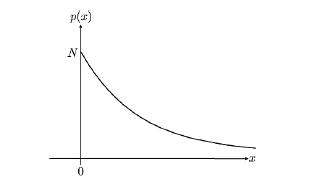We've seen simple examples of expectation value and variance in analyzing the rolls of a fair die
Question:
We've seen simple examples of expectation value and variance in analyzing the rolls of a fair die and the uniform distribution in Example 4.1. In this exercise, we will study these ideas on another very important continuous probability distribution. Consider the probability distribution \(p(x)\) for \(0 \leq x
\[
\begin{equation*}
p(x)=N e^{-\lambda x}, \tag{4.167}
\end{equation*}
\]
where \(\lambda\) is a parameter and \(N\) is the normalization constant. This distribution is illustrated in Fig. 4.3.
(a) First, determine the value of \(N\) such that the probability distribution is normalized; that is, such that
\[
\begin{equation*}
1=\int_{0}^{\infty} d x p(x) \tag{4.168}
\end{equation*}
\]
(b) Now, calculate the mean or expected value of \(x\) on this normalized distribution; that is
\[
\begin{equation*}
\langle xangle=\int_{0}^{\infty} d x x p(x) \tag{4.169}
\end{equation*}
\]
(c) Calculate the second moment of the distribution:
\[
\begin{equation*}
\left\langle x^{2}\rightangle=\int_{0}^{\infty} d x x^{2} p(x) \tag{4.170}
\end{equation*}
\]

 With this result and part (b), what are the variance and standard deviations of this distribution? Is it indeed true that "most" of the distribution is within one standard deviation of the mean?
With this result and part (b), what are the variance and standard deviations of this distribution? Is it indeed true that "most" of the distribution is within one standard deviation of the mean?
(d) The mean and variance can be generalized to define higher measures of the spread of the distribution about the mean. An \(n\)th spread for \(n \geq 2\) is
\[
\begin{equation*}
\left\langle(x-\langle xangle)^{n}\rightangle=\int_{0}^{\infty} d x(x-\langle xangle)^{n} p(x) \tag{4.171}
\end{equation*}
\]
that for \(n=2\), this spread is just the variance. Calculate the value of the \(n\)th spread on this distribution.
(e) Another measure of the average of a distribution is the median, which is defined to be the point at which there is exactly half of the area of the distribution to the left and to the right of the point. What is the median for this exponential distribution? How does the value of the median compare to the value of the mean?
Example 4.1
Example 4.1 The example of the fair die is a gentle introduction to statistical properties
of probability distributions. However, most of the measurements we can make on a
system do not return discrete values, like the die, but rather continuous values, like a
position or momentum. So expectation values or variances of continuous distributions
are defined by evaluating integrals, rather than finite sums. Let’s study a very simple
continuous probability distribution p(x) of a random variable x. We will assume that
the domain is x ∈ [0, l], for some maximum length l and p(x) is uniform, or constant, on
that domain. What is the probability distribution, it expectation value, and its variance?
Step by Step Answer:

Quantum Mechanics A Mathematical Introduction
ISBN: 9781009100502
1st Edition
Authors: Andrew J. Larkoski





